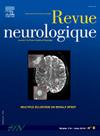Are antiseizure medications disease modifiers?
IF 2.3
4区 医学
Q2 CLINICAL NEUROLOGY
引用次数: 0
Abstract
The International League Against Epilepsy (ILAE) is proposing a new nomenclature, replacing the confusing term antiepileptic drugs (AEDs) with antiseizure medications (ASMs). This approach has been partly motivated by the emergence of new treatments with antiepileptogenic or, more precisely, disease-modifying effects. This implies an effect on the temporal course of the disease, even when treatment is discontinued. However, the terms ASM and disease-modifying are not mutually exclusive. In some cases, ASMs can have this property. however, demonstrating this disease-modifying effect, and hence the development of these molecules, remains complex and difficult. The disease-modifying effect of ASM seems to depend on its etiological or pathophysiological effect on the developing epileptic disease, but also on other characteristics: target on etiological or pathophysiological mechanisms of the disease, level of cerebral maturation, time after onset of an epileptogenic event, dosage and duration of treatment. The development of this new type of treatment requires a better definition of the target populations, a better understanding of the cascade of epileptogenic phenomena, and the definition of new diagnostic and prognostic markers for epilepsy.
抗癫痫药物是疾病调节剂吗?
国际抗癫痫联盟(ILAE)正在提出一个新的命名法,用抗癫痫药物(asm)取代令人困惑的术语抗癫痫药物(aed)。这种方法的部分原因是由于出现了具有抗癫痫作用的新疗法,或者更确切地说,具有改善疾病的作用。这意味着即使停止治疗,也会对疾病的暂时病程产生影响。然而,ASM和疾病改善这两个术语并不相互排斥。在某些情况下,asm可以具有此属性。然而,证明这种疾病修饰作用,并因此开发这些分子,仍然是复杂和困难的。ASM的疾病改善作用似乎取决于其对发展中的癫痫疾病的病因学或病理生理作用,但也取决于其他特征:疾病的病因学或病理生理机制、脑成熟水平、癫痫事件发生后的时间、剂量和治疗时间。这种新型治疗方法的发展需要更好地确定目标人群,更好地了解致癫痫现象的级联反应,并确定癫痫的新诊断和预后标志物。
本文章由计算机程序翻译,如有差异,请以英文原文为准。
求助全文
约1分钟内获得全文
求助全文
来源期刊

Revue neurologique
医学-临床神经学
CiteScore
4.80
自引率
0.00%
发文量
598
审稿时长
55 days
期刊介绍:
The first issue of the Revue Neurologique, featuring an original article by Jean-Martin Charcot, was published on February 28th, 1893. Six years later, the French Society of Neurology (SFN) adopted this journal as its official publication in the year of its foundation, 1899.
The Revue Neurologique was published throughout the 20th century without interruption and is indexed in all international databases (including Current Contents, Pubmed, Scopus). Ten annual issues provide original peer-reviewed clinical and research articles, and review articles giving up-to-date insights in all areas of neurology. The Revue Neurologique also publishes guidelines and recommendations.
The Revue Neurologique publishes original articles, brief reports, general reviews, editorials, and letters to the editor as well as correspondence concerning articles previously published in the journal in the correspondence column.
 求助内容:
求助内容: 应助结果提醒方式:
应助结果提醒方式:


